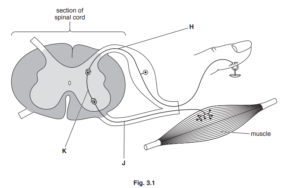Question
(a) (i) Name the structures labelled H, J and K.

Choose your answers from the following words or phrases:
effector motor neurone receptor
relay neurone sensory neurone
Write your answers in Table 3.1.
Table 3.1
| letter | name |
| H | |
| J | |
| K |
(ii) On Fig. 3.1, draw a small circle around one synapse.
(iii) State two characteristics of a reflex action.
(b) Fig. 3.2 shows what happens when a person picks up a hot object.

(i) Use Fig. 3.2 to suggest why reflex actions are important.
………………………………………………………………………………………………………………………….
………………………………………………………………………………………………………………………….
………………………………………………………………………………………………………………………….
………………………………………………………………………………………………………………………….
………………………………………………………………………………………………………………………….
………………………………………………………………………………………………………………………….
(ii) State one other reflex action in the body.
………………………………………………………………………………………………………………………….
Answer/Explanation
Ans: H sensory neurone ;
J motor neurone ;
K relay neurone ;
(ii) circle around one of the synapses (on Fig. 3.1) ;
(iii) rapid /instant /AW ;
automatic /involuntary /AW ;
co-ordinated ;
(b) (i) rapid so that further damage is avoided quickly ;
bar dropped before student is aware of pain /danger ;
co-ordinated / appropriate muscles involved ;
AVP ;
(ii) pupil reflex / knee reflex /any valid example described ;
Question
This question is about neurones and reflex actions.
Choose words from the list to complete the sentences.
Each word may be used once, more than once, or not at all.

Neurones are cells that are part of the ……………………………………….. system.
There are three types of neurone involved in a simple reflex action: a sensory neurone, a relay neurone and a ……………………………………….. neurone.
The nerves conduct electrical ……………………………………….. . These are transmitted from one neurone to the next at junctions called ……………………………………….. .
A reflex action is automatic, co-ordinated and ……………………………………….. .
Answer/Explanation
Ans:
nervous ;
motor ;
impulses ;
synapses ;
fast ;
